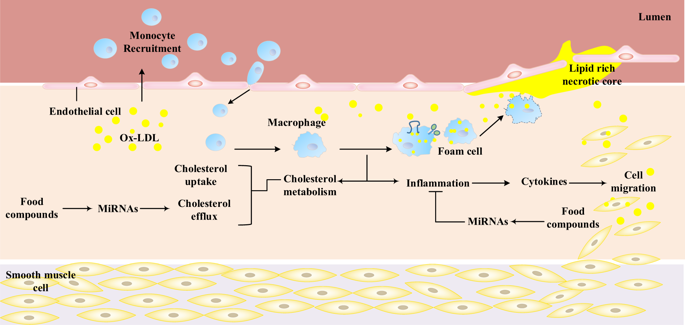npj Science of Food ( IF 6.3 ) Pub Date : 2018-07-25 , DOI: 10.1038/s41538-018-0022-8 Dongyan Shao , Ziyang Lian , Yichao Di , Lei Zhang , Muhammad shahid riaz Rajoka , Yudan Zhang , Jie Kong , Chunmei Jiang , Junling Shi

|
Atherosclerosis (AS) is a typical example of a widespread fatal cardiovascular disease. Accumulation of cholesterol-laden macrophages in the artery wall forms the starting point of AS. Increased influx of oxidized low-density lipoprotein to macrophages and decreased efflux of free cholesterol out of macrophages constitute major factors promoting the development of AS. Inflammation further aggravates the development of AS along or via interaction with the cholesterol metabolism. Many microRNAs (miRNAs) are related to the regulation of macrophage in AS in aspects of cholesterol metabolism and inflammation signaling. Dietary compounds perform AS inhibitory effects via miRNAs in the cholesterol metabolism (miR-19b, miR-378, miR-10b, miR-33a, and miR-33b) and two miRNAs in the inflammation signaling (miR-155 and miR-146a). The targeted miRNAs in the cholesterol metabolism vary greatly among different food compounds; however, in inflammation signaling, most food compounds target miR-155. Many receptors are involved in macrophages via miRNAs, including ABCA1 and ABCG1 as major receptors in the cholesterol metabolism, while nuclear factor-κB (NF-κB) and Nrf2 signaling and PI3K/AKT signaling pathways are targeted during inflammation. This article reviews current literature to investigate possible AS therapy with dietary compounds via targeting miRNAs. Currently existing problems were also discussed to guide further studies.
中文翻译:

饮食化合物具有通过miRNA调节巨噬细胞胆固醇代谢和炎症来控制动脉粥样硬化的潜力
动脉粥样硬化(AS)是广泛的致命性心血管疾病的典型例子。富含胆固醇的巨噬细胞在动脉壁中的积累形成了AS的起点。氧化的低密度脂蛋白向巨噬细胞的流入增加和游离胆固醇从巨噬细胞中流出的减少是促进AS发展的主要因素。炎症通过与胆固醇代谢的相互作用或与之相互作用进一步加剧了AS的发展。许多微小RNA(miRNA)在胆固醇代谢和炎症信号传导方面与AS中巨噬细胞的调节有关。饮食化合物通过胆固醇代谢中的miRNA(miR-19b,miR-378,miR-10b,miR-33a和miR-33b)和炎症信号中的两个miRNA(miR-155和miR-146a)发挥AS抑制作用。 。在不同食物化合物中,胆固醇代谢中的靶向miRNA差异很大。但是,在发炎信号中,大多数食物化合物都靶向miR-155。许多受体通过miRNA参与巨噬细胞,包括ABCA1和ABCG1作为胆固醇代谢中的主要受体,而炎症过程中靶向核因子-κB(NF-κB)和Nrf2信号通路以及PI3K / AKT信号通路。本文回顾了当前的文献,以研究通过靶向miRNA的饮食化合物进行AS治疗的可能性。还讨论了当前存在的问题,以指导进一步的研究。包括ABCA1和ABCG1作为胆固醇代谢的主要受体,而炎症过程中的目标是核因子-κB(NF-κB)和Nrf2信号通路以及PI3K / AKT信号通路。本文回顾了当前的文献,以研究通过靶向miRNA的饮食化合物进行AS治疗的可能性。还讨论了当前存在的问题,以指导进一步的研究。包括ABCA1和ABCG1作为胆固醇代谢的主要受体,而炎症过程中的目标是核因子-κB(NF-κB)和Nrf2信号通路以及PI3K / AKT信号通路。本文回顾了当前的文献,以研究通过靶向miRNA的饮食化合物进行AS治疗的可能性。还讨论了当前存在的问题,以指导进一步的研究。











































 京公网安备 11010802027423号
京公网安备 11010802027423号